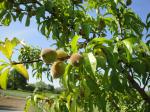BLUE SPRINGS, Mo. — Sometimes fruit trees try to produce more fruit than is good for the plant. Poor fruit size and flavor, plant stress, and alternate bearing can result when certain types of fruit trees aren’t properly thinned.
“For gardeners with fruit trees, this process may be difficult, but it’s necessary to avoid these tendencies,” said Marlin Bates, University of Missouri Extension horticulturist.
“Fruit are sink organs that accumulate sugars that are produced through photosynthesis,” Bates said. If there are too many fruit on the tree, fruit tend to remain small and don’t accumulate enough sugars.
“It takes about 25-30 leaves to provide a peach that is 3 inches in diameter with satisfactory sweetness,” Bates said. “For the best fruit, those leaves should be farther out on the same branch that the fruit is on. This means that the fruit retained after thinning should be as close to the trunk end of the branch as possible.”
Thinning this way also helps reduce plant stress. “When fruit is retained on the outer edges of the canopy, their weight can make the stems and branches droop downward,” he said. “On trees that are not adequately thinned, heavy crops can potentially lead to branch breakage and trunk splitting.”
Some fruit trees that are not properly thinned may begin alternate bearing. “This happens when a tree is sinking too much energy into developing fruit to allow for appropriate flower bud development for the next year,” he said.
The result is reduced productivity in the year after a bumper crop. Alternate bearing is perpetuated during the off year, when the tree has more than enough energy to sink into the next year’s flower buds, which will again provide a bumper crop.
On apples, pears, peaches and nectarines, thinning should be done a few weeks after fruit set, Bates said. “At this time it is easy to assess the level at which flower pollination and fertilization occurred. This is particularly important for early-ripening varieties because these varieties have a shorter period of time to appropriately ripen the fruit.”
Thin these crops to retain an average of one fruit per 6- to 8-inch section of stem. For early-ripening varieties, consider a slightly larger average spacing of about one fruit per 10-inch section of stem.
Plums can be thinned to a more dense final spacing, an average of one fruit per 3- to 4-inch section of stem. However, plums (both Japanese and European) should not be thinned until mid- to late June.
When selecting which fruit to remove, it is best to remove the fruit that is farthest out on the branch. “However, retaining larger, uniformly shaped fruit should take precedence over position,” Bates said. “Remember that the recommended spacing intervals are averages. It’s OK to have three late-season peaches close to each other as long as there is about 18-24 inches of stem there to ripen them.”
For more information on home fruit plantings, the “Home Fruit Production” series of MU Extension publications is available at www.extension.missouri.edu.
Read more http://extension.missouri.edu/news/DisplayStory.aspx?N=1415





